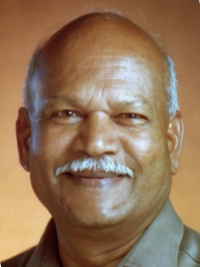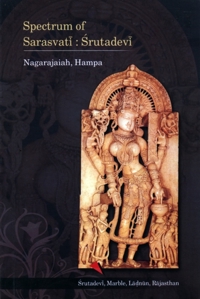The figures of Sarasvatī-Śrutadevī portrayed as standing / seated, represented in the two armed or in multi-armed form, exhibit variety in respect of iconographic forms and range in date from the second century of current era to the modern times. There are sculptures with and without vīṇā, attendants, water-vessel, lotus, goad, noose etc. Some of the attributes are arbitrary or the choice of artists. However book and rosary and haṁsa or mayūra has been constant factor.
Some times even the local taste contribute to the style of iconographic representation. Bedecked with a huge suspended garland, characteristic of Bikaner (Rajastan) images, the three surviving Śrutadevatā figures show an advancement upon the earlier idols. In some images, particularly the Murtajāpur (Rājanāpur Khinkhinī) goddess, the ornaments and the coiffure are noteworthy. Though the rendering of noose and goad in the upper two hands of the deity is very common in Deccan it is occasionally found in the northern images at Khajurāho and Devagaḍh, the two Digaṁbara seats. The Ākoṭā metal images reveal distinctive typical modelling and proportion spreading radiance.
Ākoṭā, Delvāḍa, Devagaḍh, Haḷebīḍu and Khajurāho are the most prolific Jaina sites credited with yielding more images of Śrutadevī.
Exquisitely carved metal figures of Ambikā Yakṣi, exhibiting identical features and wearing rich jewelleries, were also found in the hoard of metal images extant from Akoṭa, discovered in 1949 confirming that the place was a prolific centre of Jaina art. In fact the art of casting of Jina and other deities images by cire perdue, the lost wax process, was popular at Ākoṭā where a local style had developed from the sixth century CE. The surviving finely wrought bronze and brass images that are extant establish the prolific activity of producing cire perdue casted images at Ākoṭā. The area also forms a nucleus region for providing early images of iconographic importance.
We have noted elsewhere that Śrutadevī was accorded a very favoured position in some centres like Delvāda and Khajurāho. The heritage seat Delvāḍa or Mt. Abu (Rājasthan) has three Jinālayas;
- the Vimala Vasahī: 1031-32 CE.
- the Luna Vasahī: 1230-31 CE
- the Kharatara Vasahī: 1459 CE.
All the three temples are outstanding for their matchless architectural excellence. The marvellous carvings in marble look like lovely metallic work and profusely reflect the glory and skill of sculptors. Contrarily, Khajurāho artists preferred local variety of stone to marble. The three ancient Digaṁbara Jinamandiras, apart from 32 new Jaina shrines, at Khajurāho (MP: Chhatarpur Dt.) are -
- the Pārśvanātha temple: 950-70 CE
- the Ghaṇṭai temple: C. 985 CE
- the Ādinātha temple: c. 1070 CE
Śrutadevī figures in Jaina temples and Sarasvatī figures in Śaiva and Viṣṇu temples at Khajurāho, town of heritage temples.
Another variety of sculptural representation with significant iconographic features comes from Devagaḍh. The visual representation of Jinavānimātā have enjoyed an exalted position. Excluding independent images, the Jina-Samyukta and Yakṣī-Samyukta Śrutadevatā sculptures appear on the exterior walls, door-sills and uttarāṅga. In all these instances goddess figures two-armed and holds vīṇā. The Hoysaḷa period sculptures are famous for their aesthetically finished fine foliage and dance has been accorded a prominent place.
Invested with religio-cultural contours of Jaina tradition, the Śrutadevī images / sculptures look different from Sarasvatī, inspite of some common attributes.
Śruta or Jinavāṇi is abstract form (theory); Śrutadevatā is concrete and deified form (personification), encoding the preachings of all the 24 Tīrthaṅkaras. She is crystallization of the concept of Sarasvatī as goddess of knowledge. Sarasvatī may be consort of Brahma, but Śrutadevatā alias Jinavānimātā is not a spouse of anyone, not even Jina! She is unique. She is Kumarī, Brahmacāriṇī.
In the Jaina Iconography, the Jina images are usually similar and hence there is no scope for variety. But the artists have ceased the opportunity of bringing variety and exhibit their skill and imagination in modelling the sculptures and paintings of Yakṣas, Yakṣīs, Śrutadevatās and other deities As such, the sculptures of Sarasvatī / Śrutadevī, In the following pages, from different places and periods, reflect both popularity and variety.
 Prof. Dr. Nagarajaiah Hampana
Prof. Dr. Nagarajaiah Hampana
